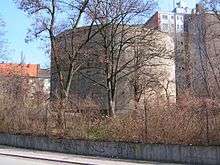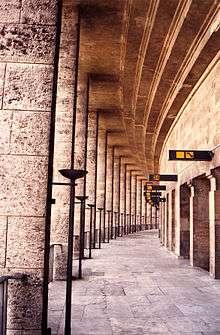Welthauptstadt Germania
.jpg)
Part of a series on the |
|---|
| History of Berlin |
| Margraviate of Brandenburg (1157–1806) |
| Kingdom of Prussia (1701–1918) |
| German Empire (1871–1918) |
| Weimar Republic (1919–33) |
| Nazi Germany (1933–45) |
| West Germany and East Germany (1945–90) |
|
| Federal Republic of Germany (1990–present) |
| See also |
Welthauptstadt Germania (pronounced [vɛltˈhaʊ̯ptˌʃtat ɡɛʁˈmaːni̯a], "World Capital Germania") refers to the projected renewal of the German capital Berlin during the Nazi period, part of Adolf Hitler's vision for the future of Germany after the planned victory in World War II. Albert Speer, the "first architect of the Third Reich", produced many of the plans for the rebuilt city in his capacity as overseer of the project, only a small portion of which was realized between the years 1937 and 1943 when construction took place.
Some projects, such as the creation of a great East-West city axis, which included broadening Charlottenburger Chaussee (today Straße des 17. Juni) and placing the Berlin victory column in the centre, far away from the Reichstag, where it originally stood, were completed. Others, however, such as the creation of the Große Halle (Great Hall), had to be shelved owing to the beginning of war. A great number of the old buildings in many of the planned construction areas were, however, demolished before the war, and eventually defeat stopped the plans.
Name
The combined name "Welthauptstadt Germania" for the project was coined by Albert Speer in his 1969 memoirs Inside the Third Reich. Although it was never used in any official capacity by the Nazi government nor even by Hitler himself, it has since become synonymous with the Nazi-era construction plan for Berlin, which was cumbersomely dubbed the "Comprehensive Construction Plan for the Reich Capital" (German: Gesamtbauplan für die Reichshauptstadt).
According to Henry Picker's records of Hitler's Table Talk of 8 June 1942 Hitler toyed with the idea of renaming the renewed Berlin 'Germania', in order to give a Greater Germanic world empire of the New Order a clear central point:
"Just as the Bavarians and the Prussians had to be impressed by Bismarck of the German idea, so too must the Germanic peoples of Continental Europe be programmatically steered towards the Germanic concept. He [Hitler] even considers it good that by renaming the Reich capital Berlin into 'Germania', we'll have given considerable driving force to this task. The name Germania for the Reich capital would be very appropriate, for in spite of how far removed those belonging to the Germanic racial core will be, this capital will instill a sense of unity.— Andreas Hillgruber: Henry Picker. Hitlers Tischgespräche im Führerhauptquartier 1941–1942, p. 182. Munich, 1968.
The term Welthauptstadt (World Capital) had already been used by Hitler three months previously on the night of the 11th March 1942 in the Wolf's Lair:
"As world capital Berlin will only be comparable with Ancient Egypt, Babylon, and Rome! What is London, what is Paris compared to that!"— Werner Jochmann: Adolf Hitler. Monologe im Führerhauptquartier 1941–1944, p. 318. Munich, 1980.
The title 'Welthauptstadt' was chosen because it was felt that Berlin's architecture was at that time too provincial, and that there was a driving need to put Berlin on a par with, and exceed the quality of, other world capitals such as London, Paris and especially Rome.
Monumental architecture planned
The first step in these plans was the Berlin Olympic Stadium for the 1936 Summer Olympics, which would promote the rise of the Nazi government. A much larger stadium capable of holding 400,000 spectators was planned alongside the Nazi parade grounds in Nuremberg, but only the foundations were dug before the project was abandoned due to the outbreak of World War II. Had this stadium been completed, it would remain the largest in the world today by a considerable margin.
Speer also designed a new Chancellery, which included a vast hall designed to be twice as long as the Hall of Mirrors in the Palace of Versailles. Hitler wanted him to build a third, even larger Chancellery, although it was never begun. The second Chancellery was destroyed by the Soviet army in 1945.
Avenue of Splendours
Almost none of the other buildings planned for Berlin were ever built. Berlin was to be reorganized along a central 5-kilometer (3.1-mile)-long boulevard known as the Prachtallee ("Avenue/Boulevard of Splendour(s)"). This would run south from a crossroads with the East-West Axis close to the Brandenburg Gate, following the course of the old Siegesallee through the Tiergarten before continuing down to an area just west of Tempelhof Airport. This new North-South Axis would have served as a parade ground, and have been closed off to traffic. Vehicles would have instead been diverted into an underground highway running directly underneath the parade route; sections of this highway's tunnel structure were built, and still exist today. No work was ever begun above ground although Speer did relocate the Siegesallee to another part of the Tiergarten in 1938 in preparation for the avenue's construction.
The plan also called for the building of two new large railway stations as the planned North-South Axis would have severed the tracks leading to the old Anhalter and Potsdamer stations, forcing their closure. These new stations would be built on the city's main Hundekopf (dog's head) geography S-Bahn ring with the Nordbahnhof in Wedding and the larger Südbahnhof in Tempelhof-Schöneberg at the southern end of the avenue. The Anhalter Bahnhof, no longer used as a railway station, would have been turned into a swimming pool - in post-World War II Moscow, this actually happened in 1958, at the building site of Joseph Stalin's never-completed Palace of the Soviets.
Großer Platz
At the northern end of the avenue on the site of the Königsplatz (now the Platz der Republik) there was to be a large open forum known as Großer Platz with an area of around 350,000 square metres (3,767,369 square feet). This square was to be surrounded by the grandest buildings of all, with the Führer's palace on the west side on the site of the former Kroll Opera House, the 1894 Reichstag Building on the east side and the third Reich Chancellery and high command of the German Army on the south side (on either side of the square's entrance from the Avenue of Splendours). On the north side of the plaza, straddling the River Spree, Speer planned to build the centrepiece of the new Berlin, an enormous domed building, the Volkshalle (people's hall), designed by Hitler himself. It would still remain the largest enclosed space in the world had it been built. Although war came before work could begin, all the necessary land was acquired, and the engineering plans were worked out. The building would have been over 200 metres (656 feet) high and 250 metres (820 feet) in diameter, sixteen times larger than the dome of St. Peter's Basilica.
Proposed First World War Arch Of Triumph and the Related Post-War Soviet War Memorial
Towards the southern end of the avenue would be a triumphal arch based on the Arc de Triomphe in Paris, but again, much larger; it would be almost a hundred metres high, and the Arc de Triomphe (at the time the largest triumphal arch in existence) would have been able to fit inside its opening, evidently with the intention of replacing the rather long history associated with this Arch and in particular the unique ceremonies, with reference to the history of France, connected with it.[1] As a result of the occupation of Berlin by Soviet troops in 1945, a memorial was constructed with two thousand of the Soviet dead buried there in line with this proposed 'Triumphal Arch'. It had been intended that inside this generously proportioned structure the names of the 1,800,000 German dead of the First World War should be carved, that which presumably was known to amongst others the Soviet leaders.[2] The outbreak of World War II in 1939 caused the decision to postpone construction until after the war to save strategic materials.[3]


Planning
Doubts persisted at the time as to whether the marshy Berlin ground could have taken the load of the proposed projects, leading to the construction of an exploration building (Schwerbelastungskörper, literal translation: heavy load-bearing body), which still exists near[4] the site where the Arch of Triumph would have been built. It is basically an extremely heavy block of concrete used by the architects to test how much weight the ground was able to carry. Instruments monitored how far the block sank into the ground. The Schwerbelastungskörper sank 18 cm in the three years it was to be used for testing, compared to a maximum allowable settlement of 6 cm. Using the evidence gathered by these gargantuan devices, it is unlikely the soil could have supported such structures without further preparation.[5] The plan was to cover the Schwerbelastungskörper by building a bridge over it. The arc would have been near by, but problems with the Axis running through infrastructure, would have made it difficult to establish any convenient location.[6]
At the time of the initial invasion of the Soviet Union (Operation Barbarossa) in June 1941, Hitler expected to win victory in World War II by 1945, and he then planned, after completing the construction of the Welthauptstadt Germania plan, to hold a great World's Fair in Berlin in 1950.[7]
See also
| Wikimedia Commons has media related to Welthauptstadt Germania. |
References
- ↑ http://www.garnison-paris.terre.defense.gouv.fr/14juillet2010/les-coulisses/historique-du-defile.htm the history of the Paris parade, Arc-de-Triomphe
- ↑ Housden, Martyn (2000). Hitler: study of a revolutionary?. Taylor & Francis. p. 151. ISBN 0-415-16359-5.
- ↑ Speer, Albert (1970). Inside the Third Reich. Simon & Schuster. ISBN 0-684-82949-5.
- ↑ information centre Schwerbelastungskörper
- ↑ History Channel, Cities Of The Underworld: Episode: 01 - Hitler's Underground Lair (5/5/07)
- ↑ information centre Schwerbelastungskörper
- ↑ Speer, Albert Inside the Third Reich New York:1970--Macmillan P.139
Further reading
Roger Moorhouse, Berlin at War: Life and Death in Hitler's Capital, 1939-1945, Bodley Head, 2010
External links
- 3D Virtual recreation by ZDF
- Report from Reuters
- Artistic discourse about recurring elements of simulated architecture and simulacra in both the actual planning and media representation of Germania (with several pictures and German text) by Erratik Institut Berlin
- Hitler's Berlin. Project Germania
- Hitler's Supercity Documentary
- Welthauptstadt Germania